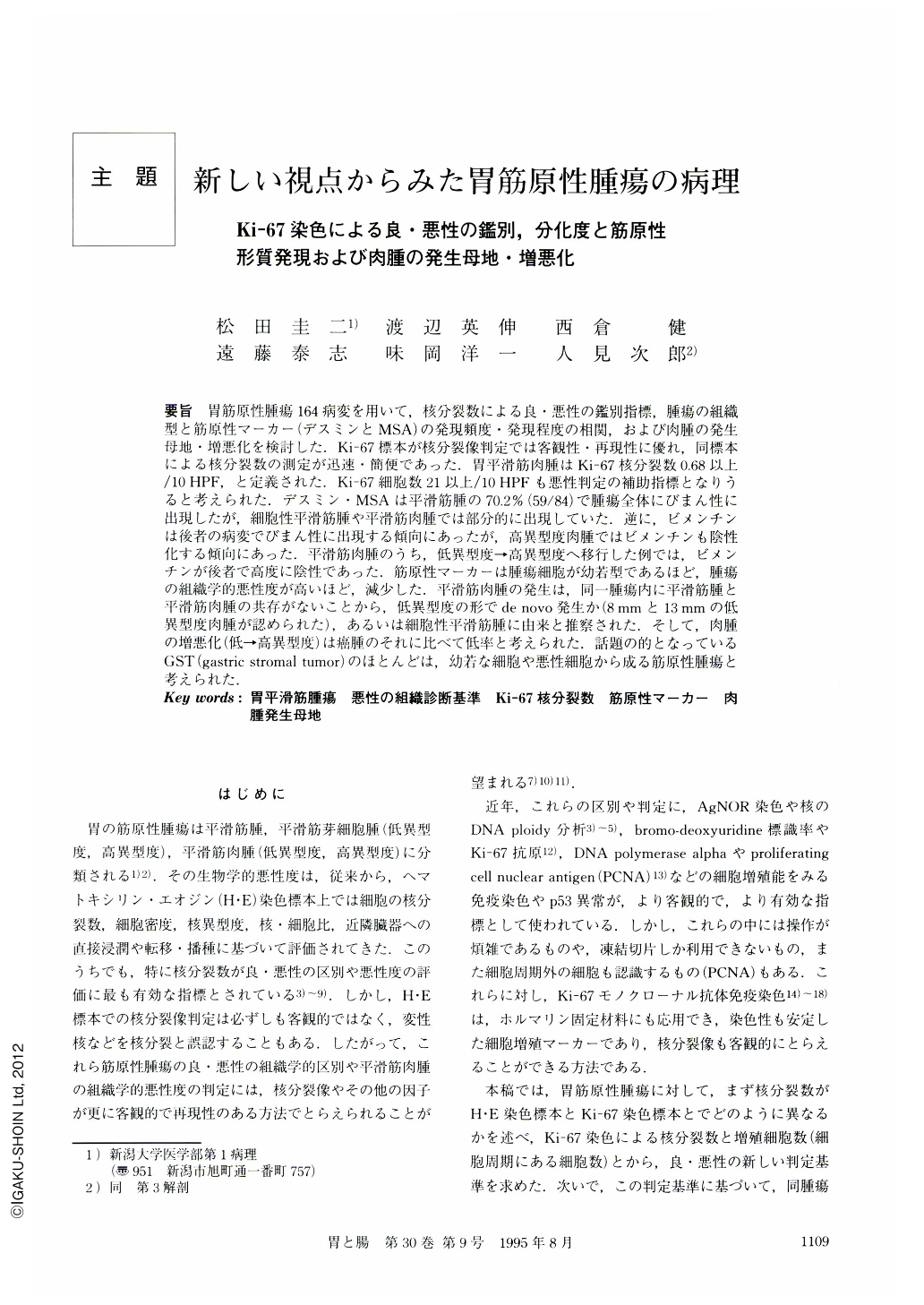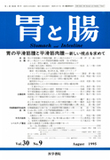Japanese
English
- 有料閲覧
- Abstract 文献概要
- 1ページ目 Look Inside
- サイト内被引用 Cited by
要旨 胃筋原性腫瘍164病変を用いて,核分裂数による良・悪性の鑑別指標,腫瘍の組織型と筋原性マーカー(デスミンとMSA)の発現頻度・発現程度の相関,および肉腫の発生母地・増悪化を検討した.Ki-67標本が核分裂像判定では客観性・再現性に優れ,同標本による核分裂数の測定が迅速・簡便であった.胃平滑筋肉腫はKi-67核分裂数0.68以上/10HPF,と定義された.Ki-67細胞数21以上/10HPFも悪性判定の補助指標となりうると考えられた.デスミン・MSAは平滑筋腫の70.2%(59/84)で腫瘍全体にびまん性に出現したが,細胞性平滑筋腫や平滑筋肉腫では部分的に出現していた.逆に,ビメンチンは後者の病変でびまん性に出現する傾向にあったが,高異型度肉腫ではビメンチンも陰性化する傾向にあった.平滑筋肉腫のうち,低異型度→高異型度へ移行した例では,ビメンチンが後者で高度に陰性であった.筋原性マーカーは腫瘍細胞が幼若型であるほど,腫瘍の組織学的悪性度が高いほど,減少した.平滑筋肉腫の発生は,同一腫瘍内に平滑筋腫と平滑筋肉腫の共存がないことから,低異型度の形でde novo発生か(8mmと13mmの低異型度肉腫が認められた),あるいは細胞性平滑筋腫に由来と推察された.そして,肉腫の増悪化(低→高異型度)は癌腫のそれに比べて低率と考えられた.話題の的となっているGST(gastric stromal tumor)のほとんどは,幼若な細胞や悪性細胞から成る筋原性腫瘍と考えられた.
We analyzed 164 gastric myogenic tumors for the purpose of making a new histological criterion of malignancy by mitotic count in Ki-67 stained sections, investigating the correlation of histological types of the tumors with frequency and grades of manifestation of cell-phenotypic markers, and elucidating the histogenesis and progression of sarcoma. The stainings of desmin, muscle specific actin (MSA), vimentin, S-100 protein, Ki-67 and p53 protein were used as cellphenotypic markers, proliferating cell (including mitotic cell) markers and markers of maligancy. The tumors were divided into benign and malignant tumors according to mitotic count by H・E stain (Newman's criteria: malignant is more than 0.52/10 HPF). We compared mitotic count in H・E section with that in Ki-67 section to know which is more suitable for judging mitotic figures. No statistically significant difference was in mitotic count between H・E stain and Ki-67 stain, but the latter was more objective and more reproducible than the former, and calculation of mitotic count by Ki-67 stain was quicker and simpler than that by H・E stain. From the present study the Ki-67 mitotic count of leiomyosarcomas was defined as more than 0.68 cells/10 HPF. And the sarcoma showed a more than 21/10 HPF Ki-67 cell count, which seems to be an assistant index for judgment of malignancy. By the Ki-67 mitotic count, the 164 lesions were classified into 84 leiomyomas, 32 cellular leiomyomas (cellularity≧220/HPF), nine leiomyoblastomas (one malignant), 35 leiomyosarcomas (31 low-grade, four high-grade), and four leiomyoshwannomas.
Leiomyomas were 100% (84/84) positive for muscle cell markers (desmin and/or MSA), cellular leio-myomas were 96.9% (31/32), leiomyoblastomas were 77.8% (7/9), leiomyosarcomas (low) were 90.3% (28/31), and leiomyosarcomas (high) were 0% (0/4). Desmin and/or MSA were diffusely positive in 70.2% (59/84) of the leiomyomas, but partially positive in all of the cellular leiomyomas, leiomyoblastomas and leiomyosarcomas. On the centrary, vimentin tended to be more diffusely positive in the latter three lesions but to be partially negative in high-grade leiomyosarcomas. In two leiomyosarcomas there were two different grades of cellular atypia, low and high grades, and the lowgrade area was diffusely positive for vimentin but the high-grade was only partially positive. From the above findings, we can conclude that the more immature tumor cells are and the more histologically malignant the tumors are, the positivity of muscle cell markers decreases.
There were no lesions containing both areas of leiomyoma and leiomyosarcoma in the same tumor. Two cellular leiomyomas, 8 mm and 13 mm in their largest diameter, were revised as low-grade leiomyosarcoma by review of H・E section and Ki-67 mitotic count. Another cellular leiomyoma showed a 0.67 cells/10 HPF Ki-67 mitotic count and a 52/10 HPF Ki-67 cell count, and two other cellular leiomyomas 0.2 and 0.3 Ki-67 mitotic count, and 99 and 96 Ki-67 cell count, respectively. These data suggest that leiomyosarcomas develop de novo as a low-grade malignancy or in cellular leiomyoma and that they progress from low-grade into high-grade (the incidence was 14.3%, 5/35 in this study, and was lower than that of colonic carcinomas).
Moreover, we can conclude that most GSTs (gastric stromal tumors) are myogenic tumors composed of immature or malignant cells in their origin because of the high incidence of myogenic markers which depend on cellular maturity.

Copyright © 1995, Igaku-Shoin Ltd. All rights reserved.


